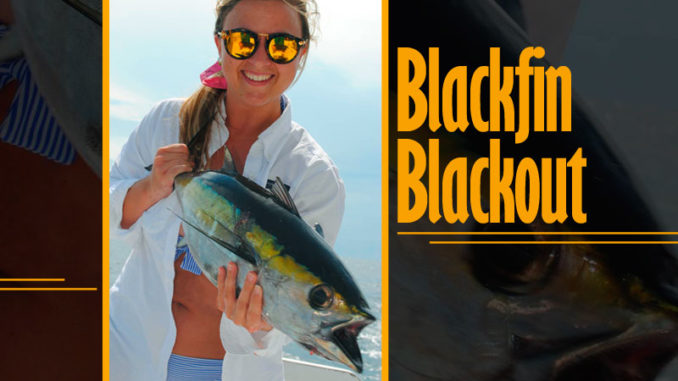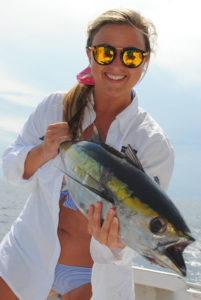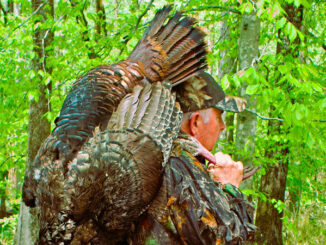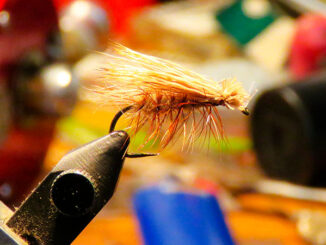
Blackfin tuna keep bluewater anglers busy in summer
With yellowfin tuna missing from most of the Carolinas’ offshore waters during the summer, bluewater fishermen are learning that blackfin tuna aren’t such a bad substitute.
Four hours out of Hatteras Landing Marina, Bruce Armstrong Jr. saw something from the bridge of his charterboat, the Sea Angel. Birds were circling about a half-mile off the stern of another boat.
“That’s tuna,” Armstrong shouted. He turned the boat’s wheel to head in the direction of the action. Before he got there, he instructed the anglers in the boat’s cabin to get ready for action.
Fifteen minutes later, a half-dozen blackfin tuna were in the fishbox. And Armstrong was trolling back and forth over what he determined to be an underwater rock pile about 70 feet in elevation, picking up a fish or two on every pass.
Two hours after the action started, Armstrong pointed the Sea Angel back toward Hatteras Inlet with 27 blackfin tuna and a couple of stray dolphin on ice. A great spring or fall day in the bluewater.
But this is July
Except that it was in the dead of July. And that’s not normally considered a don’t-miss fishing time for offshore anglers. Not even off North Carolina’s Outer Banks.
And for that, we can thank the blackfin tuna. This is the football-shaped and football-sized cousin of the more popular yellowfin, the tuna of choice along the North Carolina coast.
Except that for the past 10 years of so, yellowfins have rarely ventured south of Diamond Shoals northeast of Hatteras. That’s especially true after Memorial Day.
“The yellowfins are here in April and early May. But after Memorial Day, south of the shoals, you don’t catch yellowfin all summer except for an occasional fish. The yellowfins get north of the shoals, in that blended water with the Labrador current (and Gulf Stream),” said Armstrong. He took over the Sea Angel several years ago from his father. “The blackfin show up in April. The biggest ones come earlier in the year, but the smaller ones stay here all summer, up to 15 pounds.
“They have replaced yellowfins as our summertime tuna. Hatteras has always been known for dolphin and always will be. But these tuna are great for our fishery.”
Trolling is the key to blackfin tuna

Armstrong and captains out of a handful of Hatteras marinas have made blackfin tuna a big part of their summer plans. He spends a lot of time between 35 and 40 miles south of Hatteras Inlet, fishing around popular offshore spots. These include the Rockpile and Triple Zeros, and along spots identified by old LORAN coordinates: the 890 rocks, the 980 and 990 lines.
“You usually find them around some kind of bait, probably flying fish. You’ll also catch some skipjack tuna mixed in with them, especially around rocks,” Armstrong said. “You can watch and see ’em busting in front of the boat or to the sides.”
Armstrong normally trolls a mixed spread of ballyhoo and sea witches, plus some squid and teasers. When he knows blackfin are in the area, he’ll replace every lure in his spread of seven or eight rods with Green Machines, small, green squid, fished behind trolling birds of various sizes. On the biggest birds, he’ll run two Green Machines, calling it a “Double Trouble.”
Summertime blackfin range from 6 to 20 pounds
“I will use small, medium or large Green Machines behind birds or squid chains,” Armstrong said. “The biggest bird, 15 inches, I’ll drop off two leaders of 100-pound fluorocarbon, 6- and 10-foot leaders, and clip them to the back of the birds. We catch a lot of doubles that way.
“I’ll troll at about 5 knots. If I’m going against the current, I might be only moving 3 knots. When we get one (blackfin) on, I’ll slow down. Then I’ll have the fishermen jig all the rods and get the rest of them up to the surface. It’s best to keep the boat moving and leave the rods in the holders when they start popping up.”
Armstrong said most of the summer blackfin are literally “football tuna” — anywhere from 6 to 10 pounds. About one out of every half-dozen or so will be bigger, pushing 15 or 20 pounds.
DESTINATION INFORMATION
HOW TO GET THERE — Hatteras is on NC 12 at the southern end of the Outer Banks, just across Hatteras Inlet from Ocracoke Island, about 50 miles south of Nags Head
WHEN TO GO — Blackfin tuna, along with dolphin, make up the lion’s share of the summer offshore catch out of Hatteras. The biggest fish are around in late spring, along with bigger yellowfin tuna, which virtually disappear south of Diamond Shoals, after Memorial Day. Plenty of 6- to 12-pound school tuna are caught through the summer.
BEST TECHNIQUES — Troll with a spread of small Green Machines behind a trolling bird or a squid chain. Add in ballyhoo on bright-colored sea witches to tempt any dolphin you run into.
FISHING INFO/GUIDES — Bruce Armstrong, Sea Angel (252-904-7385); Hatteras Landing Marina, 252-986-2077; Hatteras Harbor Marina, 252-986-2166; Teach’s Lair Marina, 252-986-2460; Oden’s Dock, 252-986-2555. See also Guides and Charters in Classifieds.
ACCOMMODATIONS — Dare County Visitors Bureau, 877-629-4386, www.outerbanks.org.
MAPS — Capt. Segull’s Nautical Charts, 888-473-4855, www.captainsegullcharts.com; Sealake Fishing; Guides, 800-411-0185, www.thegoodspots.com; Maps Unique, 910-458-9923, www.mapsunique.com.
Click here to read about the North Carolina state record blackfin tuna.




